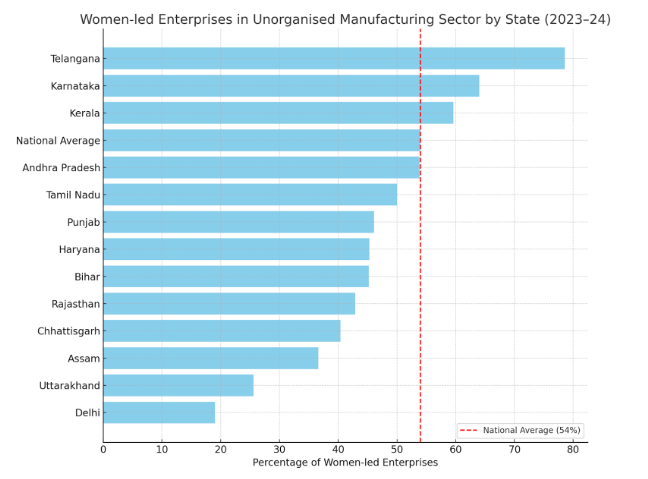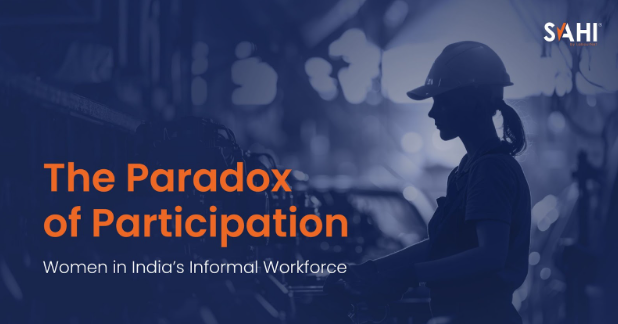Let’s look at some factors affecting women in the workforce:
- Low Participation Rates: As of 2023, only 31.2% of Indian women aged 15 and above were active in the labor force, compared to 76.8% of men, highlighting a significant gender gap in employment.
- High Vulnerability in Employment: Approximately 79.6% of employed women in India are engaged in vulnerable employment, characterized by inadequate earnings, low productivity, and lack of social protection. This is higher than the 70.1% observed among men.
- Lack of Job-Ready Skills Among Urban Women: A 2023–24 survey by IFMR-LEAD and ISI Delhi highlighted a significant gap between women’s educational qualifications and the practical skills required in the job market. Delhi and Bengaluru have 60% of women who report not having the skills needed for a well-paying, stable job. 57% lacked adequate skills for job interviews, and half were unsure how to even prepare a resume.
- Informal Sector Dominance: A significant proportion of Indian women work in the informal sector, which often lacks job security, benefits, and legal protections.
- Gender Norms and Safety Concerns: Cultural expectations and safety issues restrict women’s mobility and employment opportunities, especially in certain regions and sectors.
- Limited Access to Resources: Women face challenges in accessing financial services, digital tools, and networks that are crucial for employment and entrepreneurship.
- 43% of women of India’s workforce exist in Low-Paying, Low-Skill Jobs in the informal manufacturing sector. This overrepresentation indicates a mismatch between women’s potential and the nature of jobs they occupy.

While these statistics in the above chart are encouraging and some states are making great strides in the manufacturing sector, it’s clear that there’s still a long way to go in promoting women’s leadership across the country, with most of the above figures still falling short of the national average of 54%.
When women step into higher-value roles—whether in formal employment or entrepreneurship—the entire economy benefits. We see a boost in productivity and overall output. But increasing female labor force participation isn’t just about creating more jobs. It also leads to better income distribution, enhanced consumer spending power, and greater economic resilience. In short, when women thrive in the workforce, we all win!
The World Bank’s Gender Strategy Update 2024–30 highlights a compelling opportunity in closing gender gaps in labor force participation. It could boost global GDP per capita by an impressive 20%, emphasizing the substantial economic advantages of achieving gender parity in the workplace. According to the McKinsey Global Institute, advancing gender equality in India alone could contribute a staggering $770 billion to the country’s GDP by the end of 2025. That’s a game-changer!
What Needs to Happen?
So what can India do to close this gap? What are some ways in which India can promote women’s participation in the workforce to harness this potential for substantial economic growth.
Addressing these challenges requires a multifaceted approach involving government initiatives, private sector engagement, and societal shifts to create an inclusive and supportive environment for women’s employment in India. They include:
- Skill Development: Implementing targeted training programs can equip women with the skills needed for formal sector jobs.
- Policy Reforms: Introducing policies that promote flexible work arrangements, ensure workplace safety, and provide childcare support can facilitate women’s employment.
- Access to Finance and Technology: Improving women’s access to financial services and digital tools can empower them to pursue entrepreneurial ventures and participate in the digital economy.
Achieving gender parity in India’s workforce isn’t just about fairness — it’s smart economics. Empowering women to participate fully in the economy could unlock billions in GDP gains, ensure inclusive growth, and help India truly realize its demographic dividend. Workforce Development Models like SAHI’s are essential to reaching this goal.
SAHIs model pivots on:
- Equipping women with job-aligned, work-integrated skills
- Facilitating local, flexible, and formal work opportunities
- Providing wraparound support (housing, transport, contracts)
- Engaging employers in inclusive hiring and retention activities.
When women in the informal sector are supported in their career journeys, they gain financial independence, improve household well-being, and become key drivers of change for everyone.
Are you driving change the SAHI way?



